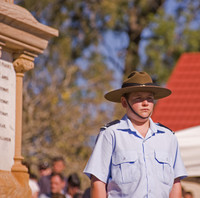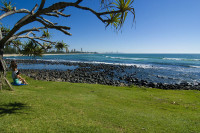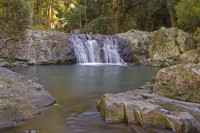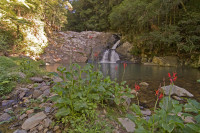For Anzac day i thought i would go visit the local Memorial expecting a very small service beside the Uniting Church and Cemetery at Pimpama but when i arrived i found quite a large gathering for such a small rural area.

Legend has it that the first Catafalque Parties or Catafalque Guards were used to guard important and wealthy persons's coffins from theives and vandals before they were entombed or buried.
A Catafalque is actually a raised platform that supports a pier on which a coffin rests and, in modern times, a Catafalque may be represented by a shrine or rememberance stone for ceremonial purposes.
A Catafalque Party is a guard that is mounted over a Catafalque on any one of a number of different occasions such as around the coffin of a distinguished person during a period of lying in state; for a service person during a military funeral that is being carried out in a church, or around a shrine or rememberance stone at a memorial of special occasion such as Anzac Day or on Rememberance Day.
The Catafalque Party mount the Catafalque with the flags at full mast...

the Catafalque Guards stand quite still for the whole ceremony ...



the Anzac Memorial and flag masts


Speeches were said while others watched ...



The "Last Post" is one of a number of Bugle calls in military tradition that marks the phases of the day. The "Last Post" signals the end of the day.
Its origins date back to the 17th century where it was part of a more elaborate routine knows in the British Army as "Tattoo". in those days wars and battles were much more civilised, with fighting taking place only during the daylight hours.
Consequently, during the evening, a duty officer would do the rounds of his units position, checking that the sentry posts were all manned and rounding up the off-duty soldiers and packing them off to their beds.
On his rounds the duty officer would be accompanied by one or more musicians. The "First Post" was sounded when the duty officer started his rounds and, as the party proceeded from post to post, a drum was played.
Another Bugle call was sounded when the party completed their rounds when they reached the "Last Post".
The Last Post bugle call signalled that the night sentries were alert at their posts. This also gave one last warning to any soldiers still at large that it was time to retire for the evening.
Over time, the Last Post has been incorporated into military funerals and memorial services as a final farewell to servicemen and women and symbolises that the duty of the dead is over and that they can rest in peace.
Wreaths are laid, the Buglar plays "The Last Post" and flags are lowered ...



Photos are taken in front of the memorial ...


With the ceremony over some songs are sung as An F111 flys low overhead on its way back to base from further down south.


































